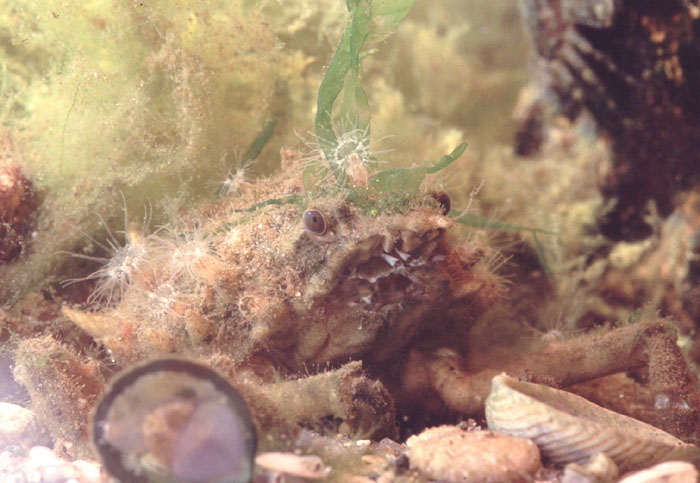There are times when I regret not going to college, and finding out more about some of the things that interest me on a regular basis. But then I think about it, and realize right now I can concentrate on certain topics without having to satisfy some requirement for things I couldn’t care less about. So I guess the glass is still half unbroken, or something like that.

Anyway, say hello to a common spider crab (Libinia emarginata) that can be found in Florida waters, among many other places. [The blotch in the left foreground is a slipper snail on the aquarium glass]. They’re shy, and their pincers are tiny and good only for feeding, so they utilize defensive camouflage, but in a totally cool way. They have the ability and instinct to obtain pieces of seaweed and plant them across their upper carapace with the help of a strange texture on its surface, and in this way, they blend into their typical habitat of seaweed-covered rocks. My specimen here, caught by hand and photographed within a fish tank, also sports quite a few small anemones, those ghostly white fringes all over its back. Whether it actually planted them itself or they simply liked it as a host, I cannot say.
Unfortunately, there’s a lot I cannot say about this one, but I’m trying to locate the answers to my questions, and plan to update this post when I have them. You see, simple coloration camouflage I understand. Simple behavioral traits, like holding still, I understand. But this is something different. Here we have a species that not only has a specialized physical trait, Velcro-like hooks in spots on the chitin called setae (which may even provide a preferential surface for anemones), but a specific behavior too, one that doesn’t seem to serve a combined or translatable purpose. You see, in order to get the seaweed to stay put, the crab actually chews the ends into a fray that catches on its setae, then puts the seaweed in place. Some studies have shown that it knows what seaweeds are more repugnant to its predators and preferentially chooses them. It has also been shown that this is more prevalent with the younger, smaller crabs, and that both the surface and the behavior disappear as they get older and less threatened by predators.
 Evolution can be a convoluted thing, and the processes that lead to the forms we see now aren’t always easy to determine. The process of choosing select seaweeds, preparing them with a compatible surface, and placing them on its body has the deceptive appearance of reasoning and foresight, something that is undoubtedly lacking – crab brains aren’t very complicated. This is an ingrained process that’s been selected for over a very long period, but just how do you select for it?
Evolution can be a convoluted thing, and the processes that lead to the forms we see now aren’t always easy to determine. The process of choosing select seaweeds, preparing them with a compatible surface, and placing them on its body has the deceptive appearance of reasoning and foresight, something that is undoubtedly lacking – crab brains aren’t very complicated. This is an ingrained process that’s been selected for over a very long period, but just how do you select for it?
It’s easy with adaptive traits like color. The harder it is to see a species, the harder it is to find it and eat it, so the ones with color that more closely matches the surroundings get eaten less and reproduce more, passing on those color genes. Simple. But a behavior that also relies on a specialized physical trait is something else, one that’s hard to work backwards from (and that, so far, I have not found answered by research.) I could perhaps see that the setae might have snagged seaweed by itself while the crab moved through a mass of it, and thus the crabs that grew rougher spots on their carapaces gained a camouflage benefit from the incidental adherence of stray vegetation. So, how did it evolve a behavior to place chewed stems on its back? I could spend a lot of time speculating, and have, but it hasn’t led anywhere convincing, nor do I think my guessing is meaningful in any way. We know, through roughly 150 years and uncountable hours of research, that these kinds of things develop in small increments over long periods of time. I just find it fascinating the traits that have been produced by the process, with only a few basic rules to produce them.



















































